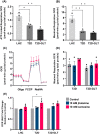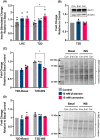Carnosine increases insulin-stimulated glucose uptake and reduces methylglyoxal-modified proteins in type-2 diabetic human skeletal muscle cells
- PMID: 36637533
- PMCID: PMC10038967
- DOI: 10.1007/s00726-022-03230-9
Carnosine increases insulin-stimulated glucose uptake and reduces methylglyoxal-modified proteins in type-2 diabetic human skeletal muscle cells
Abstract
Type-2 diabetes (T2D) is characterised by a dysregulation of metabolism, including skeletal muscle insulin resistance, mitochondrial dysfunction, and oxidative stress. Reactive species, such as methylglyoxal (MGO) and 4-hydroxynonenal (4-HNE), positively associate with T2D disease severity and can directly interfere with insulin signalling and glucose uptake in skeletal muscle by modifying cellular proteins. The multifunctional dipeptide carnosine, and its rate-limiting precursor β-alanine, have recently been shown to improve glycaemic control in humans and rodents with diabetes. However, the precise mechanisms are unclear and research in human skeletal muscle is limited. Herein, we present novel findings in primary human T2D and lean healthy control (LHC) skeletal muscle cells. Cells were differentiated to myotubes, and treated with 10 mM carnosine, 10 mM β-alanine, or control for 4-days. T2D cells had reduced ATP-linked and maximal respiration compared with LHC cells (p = 0.016 and p = 0.005). Treatment with 10 mM carnosine significantly increased insulin-stimulated glucose uptake in T2D cells (p = 0.047); with no effect in LHC cells. Insulin-stimulation increased MGO-modified proteins in T2D cells by 47%; treatment with carnosine attenuated this increase to 9.7% (p = 0.011). There was no effect treatment on cell viability or expression of other proteins. These findings suggest that the beneficial effects of carnosine on glycaemic control may be explained by its scavenging actions in human skeletal muscle.
Keywords: Diabetes; Glycaemia; Metabolism; Prediabetes; Therapeutics.
© 2023. The Author(s).
Conflict of interest statement
Author disclosures: CS is the recipient of funding to support a PhD program of work from the Natural Alternatives International (NAI) and has received
Figures


Similar articles
-
Insulin does not stimulate β-alanine transport into human skeletal muscle.Am J Physiol Cell Physiol. 2020 Apr 1;318(4):C777-C786. doi: 10.1152/ajpcell.00550.2019. Epub 2020 Feb 26. Am J Physiol Cell Physiol. 2020. PMID: 32101455
-
Obesity, type 2 diabetes, and impaired insulin-stimulated blood flow: role of skeletal muscle NO synthase and endothelin-1.J Appl Physiol (1985). 2017 Jan 1;122(1):38-47. doi: 10.1152/japplphysiol.00286.2016. Epub 2016 Oct 27. J Appl Physiol (1985). 2017. PMID: 27789766 Free PMC article.
-
Modeling and Phenotyping Acute and Chronic Type 2 Diabetes Mellitus In Vitro in Rodent Heart and Skeletal Muscle Cells.Cells. 2023 Dec 7;12(24):2786. doi: 10.3390/cells12242786. Cells. 2023. PMID: 38132105 Free PMC article.
-
The Physiological Roles of Carnosine and β-Alanine in Exercising Human Skeletal Muscle.Med Sci Sports Exerc. 2019 Oct;51(10):2098-2108. doi: 10.1249/MSS.0000000000002033. Med Sci Sports Exerc. 2019. PMID: 31083045 Review.
-
Muscle carnosine metabolism and beta-alanine supplementation in relation to exercise and training.Sports Med. 2010 Mar 1;40(3):247-63. doi: 10.2165/11530310-000000000-00000. Sports Med. 2010. PMID: 20199122 Review.
Cited by
-
Sitting Interruption Modalities during Prolonged Sitting Acutely Improve Postprandial Metabolome in a Crossover Pilot Trial among Postmenopausal Women.Metabolites. 2024 Aug 30;14(9):478. doi: 10.3390/metabo14090478. Metabolites. 2024. PMID: 39330485 Free PMC article.
-
Carnosinase-1 Knock-Out Reduces Kidney Fibrosis in Type-1 Diabetic Mice on High Fat Diet.Antioxidants (Basel). 2023 Jun 14;12(6):1270. doi: 10.3390/antiox12061270. Antioxidants (Basel). 2023. PMID: 37372000 Free PMC article.
-
β-alanine supplementation in adults with overweight and obesity: a randomized controlled feasibility trial.Obesity (Silver Spring). 2025 Feb;33(2):278-288. doi: 10.1002/oby.24204. Epub 2025 Jan 12. Obesity (Silver Spring). 2025. PMID: 39800667 Free PMC article. Clinical Trial.
-
Acetylcholine Sustains LNCaP Prostate Cancer Cell Migration, Invasion and Proliferation Through Glyoxalase 1/MG-H1 Axis with the Involvement of Osteopontin.Int J Mol Sci. 2025 Apr 25;26(9):4107. doi: 10.3390/ijms26094107. Int J Mol Sci. 2025. PMID: 40362346 Free PMC article.
-
Elevated Methylglyoxal: An Elusive Risk Factor Responsible for Early-Onset Cardiovascular Diseases in People Living with HIV-1 Infection.Viruses. 2025 Apr 8;17(4):547. doi: 10.3390/v17040547. Viruses. 2025. PMID: 40284990 Free PMC article. Review.
References
-
- Aldini G, de Courten B, Regazzoni L, Gilardoni E, Ferrario G, Baron G, Altomare A, D’Amato A, Vistoli G, Carini M. Understanding the antioxidant and carbonyl sequestering activity of carnosine: Direct and indirect mechanisms. Free Radic Res. 2021;55(4):321–330. doi: 10.1080/10715762.2020.1856830. - DOI - PubMed
MeSH terms
Substances
LinkOut - more resources
Full Text Sources
Medical

